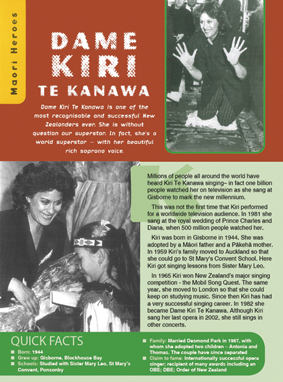| Approach: Station |
Level:
Year 8 |
|
| Focus:
Organising
and summarising information |
| Resources:
Information card |
 |
1.6MB |
|
|
Questions
/ instructions:
Here is some information about Kiri Te Kanawa from a book called,
Alan Duff’s Mäori Heroes.
Read the information about Kiri Te Kanawa. |
| Dame
Kiri Te Kanawa
Dame Kiri Te Kanawa is one of the most recognisable
and successful New Zealanders ever. She is without question our
superstar. In fact, she’s a world superstar – with
her beautiful rich soprano voice.
Millions of people all around the world have heard Kiri Te Kanawa
singing– in fact one billion people watched her on television
as she sang at Gisborne to mark the new millennium.
This was not the first time that Kiri performed for a worldwide
television audience. In 1981 she sang at the royal wedding of
Prince Charles and Diana, when 500 million people watched her.
Kiri was born in Gisborne in 1944. She was adopted by a Mäori
father and a Päkehä mother. In 1959 Kiri’s family
moved to Auckland so that she could go to St Mary’s Convent
School. Here Kiri got singing lessons from Sister Mary Leo.
In 1965 Kiri won New Zealand’s major singing competition
- the Mobil Song Quest. The same year, she moved to London so
that she could keep on studying music. Since then Kiri has had
a very successful singing career. In 1982 she became Dame Kiri
Te Kanawa. Although Kiri sang her last opera in 2002, she still
sings in other concerts.
QUICK FACTS:
•
Born: 1944
• Grew up: Gisborne, Blockhouse Bay
• Schools: Studied with Sister Mary Leo, St Mary’s
Convent, Ponsonby
• Family: Married Desmond Park in 1967, with whom she
adopted two children – Antonia and Thomas. The couple
have since separated
• Claim to fame: Internationally successful opera singer;
recipient of many awards including an OBE; DBE; Order of New
Zealand
|
 |
| The
information you have just read is a bit muddled up. Make short notes
about Kiri’s life so that things are listed in the order they
happened. |
|
|
| |
|
%
responses
2005 |
| Y4 |
Y8 |
Notes
about early life include:
|
|
|
|
Relevant
features:
(born in Gisborne; born in 1944; adopted; parents; grew up in Gisborne
and Blockhouse Bay, Auckland) |
| |
4
or more relevant points |
|
37 |
2-3
relevant points |
|
43 |
1
relevant point |
|
8 |
any
other response |
|
12 |
|
Notes about education include: |
|
|
Relevant
features:
(attended St Mary’s Convent School; singing lessons from Sister
Mary Leo; studied music in London from 1965) |
| |
3
relevant points |
|
5 |
2
relevant points |
|
43 |
1
relevant point |
|
33 |
any
other response |
|
19 |
| Notes
about career include: |
|
|
Relevant
features:
(watched by 1 billion people in 2000; sang at wedding of Prince Charles
and Lady Diana Spencer; won Mobil Song Quest; became Dame Kiri Te Kanawa;
sang last opera in 2002; has rich soprano voice; is a superstar; has successful
singing career as an opera singer) |
| |
6
or more relevant points |
|
1 |
4-5
relevant points |
|
13 |
2-3
relevant points |
|
43 |
1
relevant point |
|
29 |
any
other response |
|
14 |
| Overall
note taking style |
|
|
| |
succinct
paraphrased notes |
|
22 |
mixture
of paraphrasing and copying |
|
54 |
sections
of texts copied |
|
15 |
any
other response |
|
9 |
Total
score: 10–12 |
|
13 |
8–9
|
|
35 |
6–7
|
|
27 |
4–5
|
|
14 |
0–3
|
|
11 |
Commentary:
This task
was distinctly unpopular with the year 8 students. Forty-eight percent
scored 8 or more, indicating that they captured and classified correctly
a substantial number of relevant points and recorded them appropriately.
|